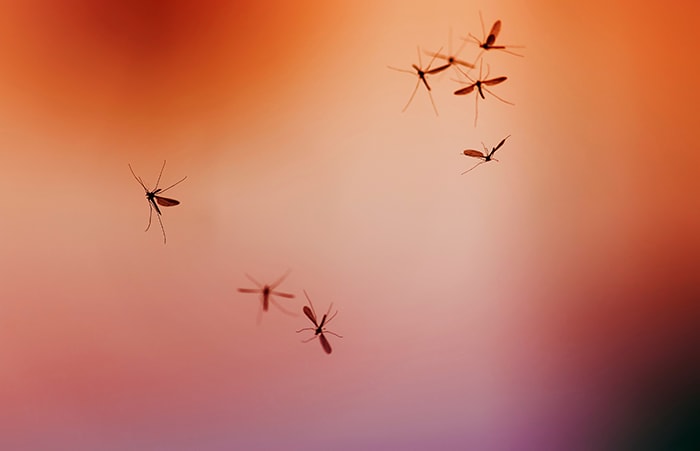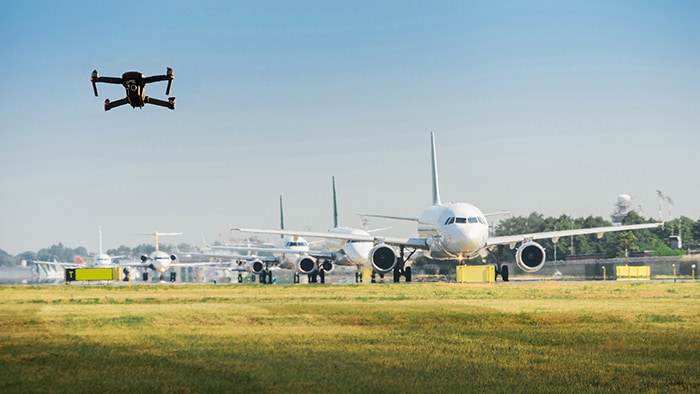Protected Airspace: A Look at Counter-Drone Technology

By Paul Golata, Mouser Electronics
Published March 9, 2022
Protected Airspace
I am presently writing in the depths of winter. Due to freezing precipitation, icy roads, and snow, the metropolis is shut down. The outside temperature is -10C. My car doors are frozen shut. I am dreaming of summer. A time when one engages in backyard charcoal cookouts. I can taste the hamburger and bacon right now. But there is always one problem with backyard summer grilling. Those pesky flies, gnats, and mosquitoes come out at night (Figure 1). Oh boy, are they bothersome. I have to fight them off with fly swatters, Citronella candles, electric bug zappers, and organic concoctions of insect repellent in order to keep them away from my friends and family. Otherwise, they keep buzzing around, landing on people’s food, or even biting people (darn horseflies and mosquitoes). During the summer, I am involved in protecting my backyard airspace from these unwanted invaders. And then, once I have nature under control (somewhat), I hear a buzzing coming over the fence. The last thing I want is to have to fend off is a swarm of drones flying in the neighborhood, disrupting my BBQ activities.

Figure 1: Swarm of insects flying and buzzing. (Source: nataba/stock.adobe.com)
Drones
Drones have become synonymous with unmanned aerial vehicles (UAVs) and unmanned aircraft systems (UASs) technology. The term UAVs typically corresponds to the asset flying in the air. In contrast, the term UASs implies the inclusion of the aerial asset with all its supporting technology on the ground and any human control. Drones quickly found applications within the military context, becoming tools to employ on military missions considered too risky due to the possibility of the loss of human life or too repetitive and monotonous for constant human involvement via the air. Drones may be classified by criteria including their mass (kg), velocity (m/s), altitude ceiling (m), and level of autonomy—from remotely human-controlled to fully autonomous.
Counter-Drones
With the availability of low-cost, ubiquitous, increasingly sophisticated, and complex UAVs/UASs (henceforth UAVs), the challenge arises on how to assess, mitigate, and protect against nefarious drone activities. This article will discuss some of the technology behind the different counter-drone or anti-drone efforts (henceforth: Counter-drone), the features of protective counter-drone technology, and how this technology may find deployment outside of military applications. The counter-drone focus will be on the situational awareness needed to detect, track, and classify, with the issue of how to disable and mitigate the nefarious drone largely left unexplored.
Location Monitoring
Privately- or corporately-owned and -controlled drones represent potential threats to civilian structures and institutions. These threats may be to physical objects, such as local airports and air traffic (Figure 2), or through surveillance/spying/intellectual property (IP) theft involving critical infrastructures, corporations, and sporting events. Additionally, drones offer a possible hazard to large or mass gatherings of people such as schools, parades, traffic jams, and rallies. Nefarious actors could also attempt to violate prison boundaries, deploying drones with explosive munitions, or employ them for other forms of terrorism. To that end, local and private authorities must create general and specific plans for how to protect their assets with counter-drone shielding. In other words, they must determine what they will monitor and how they will monitor for drones. Due to limited resources, full-spectrum protection may get prioritized on what is deemed most essential. The desire is to develop the earliest possible threat detection so that potential nefarious drones can be tracked, classified, interdicted, intercepted, or destroyed.

Figure 2: An unmanned drone flying near an airport may cause disruptions to flight traffic. (Source: Alexandre Rotenberg/stock.adobe.com)
Detection and tracking
The human body is an incredible biological system. A human’s five (5) senses provide them with a host of contextual information and signals to detect what is happening around them. To employ counter-drone technology, engineers must design electronic-based, counter-drone systems. Taking their design cues from the biological world around them, engineers recognize that detection schemes using electronic sensing systems can enable them to hear or see potentially nefarious drones.
Hearing: Acoustic Sensors
The bee flaps its wings at a pace of around 200 times a second, which creates a small audible signature. If you find yourself amid a swarm of bees, it can be loud and intimidating.
System engineers can employ sensitive passive acoustic sensors, primarily in the form of microphones or microphone arrays, to pick up the acoustic noise generated by singular or multiple (swarms) drones. Despite the relatively small audible sound a drone might make, the use of acoustic amplifiers coupled with intelligent frequency filters, devices, and algorithms may be able to sort out and identify when a drone has entered a protective airspace zone. These acoustic algorithms may get potentially augmented by utilizing artificial intelligence (AI) and machine learning (ML). Acoustic detection often allows the system to coarsely triangulate the detected drone. It is also a great option because it supplements vision sensing (seeing) that may require line-of-sight (LOS) capabilities. Naturally, it is easier to employ in quieter and wide-open spaces.
Seeing: Vision and Camera Sensors
Bees can see across the 300nm–600nm light spectrum. Compared to humans (400nm–700nm), bees can see into the ultraviolet (UV) region (<400nm) and are blind to red light (>600nm). A bee has a compound eye composed of around 8,600 facets. The bees’ sight allows them to find flowers. Humans have deployed cameras on drones, enabling them to capture and record things for humans to watch not only within the human spectrum, but also potentially beyond human sight with infrared (IR) or UV cameras. Forward-looking infrared (FLIR) or similar cameras may be used to provide a way to have sight in the darkness or observe thermal images. Recordings may be made to have evidence of what transpired. Vision systems on drones require line-of-sight (LOS) because light travels in a straight line. Detection through visual observation requires additional sensing capabilities because if the drone is not in a LOS, the counter-drone is blind. Counter-drones may be strategically equipped with a host of extended capabilities to upgrade their vision-sensing capabilities to operate in various contexts. Vision systems are subject to poor performance in more challenging environments such as darkness and precipitation. False-alarm rates may also be higher in vision systems as a result of misclassification of the detected object.
UASs incorporating AI and control centers may utilize a UAV with a universal serial bus (USB) 3.0 camera. This camera can continuously monitor the restricted airspace and provide a wide field of view (FoV). Basler is a leading manufacturer of high-quality digital cameras and accessories for such applications. Products such as the Basler ace U USB 3.0 camera meet drone detection’s critical requirements.
Reflect to Detect
Another way to detect drones is more akin to the technique’s bats employ. Instead of using acoustic sound navigation and ranging (SONAR), radio (electromagnetic radiation) detection and ranging (RADAR) gets used. An active manner would be for radio frequency (RF) signals to get sent out, usually in a short time duration burst, from a transmitter (Tx), flooding the air zone with RF signals. Items within this covered airspace zone reflect (echo) these RF signals back to where they get picked up by an RF receiver (Rx). These reflections get used to map out the objects with the protected air space. The reflected signal additionally contains directional and velocity information. These systems can work over great distances while providing real-time tracking and coverage. It can handle multiple targets simultaneously, such as swarms, and are not contingent on environmental conditions. Because RF signals are getting emitted, this generally falls into a classification that requires adherence to frequency transmission requirements established by appropriate authorities to avoid interference impacts on other surrounding contexts.
Since drones rely on RF signals (such as those in the following frequency bands: 1.2GHz, 1.3GHz, 2,4GHz, and 5.8GHz), a passive method is to listen to these spectrums with an RF sensor. If the RF sensor and subsequent analysis detect and identify a drone communication protocol employed, it can provide an alert.
Interdiction through Interruption
Tactical interdiction means delaying or disrupting nefarious forces before arriving at or onto the scene. In the case of counter-drone technology, it means to prohibit the suspect drones from entering the protected airspace preemptively. Once suspect drones are detected, somebody can direct an RF jammer or a high-power microwave (HPM) device toward the drone (Figure 3). These signal interrupters may be structurally mounted or mobile. They may direct a high-energy beam, such as an electromagnetic pulse (EMP), toward the drone, which will, in effect, render the controller blind, unable to communicate, or confounding the drone’s sense of its Global Positioning System (GPS) coordinates.

Figure 3: UAV drone jammer system for counter-drone protection of a restricted area, no-fly drone zone. (Source: rumruay/stock.adobe.com)
When control is lost, drones are then generally programmed to either (a) land safely, (b) return to Home, (c) fall out of the sky like a drone version of Icarus, or (d) go flying off randomly and uncontrollably to who knows where. Both options (c) and (d) may have serious negative consequences. RF jammers rely on a non-kinetic form of interdiction. Further, HPMs may impact unintended electronics that are within the EMP’s path, potentially causing collateral damage.
Interception
Kinetic forms of counter-drone technology are also available. These forms generally fall into a realm of interception or destruction. This action is usually warranted when the decision timeframe or window for other action has passed. The perceived risks are judged to be too grave and weighty to endure further delay. The situation has come to a point where an end must be reached, and the threat must get neutralized as soon as possible.
One manner for interception is pelengation. Pelengation permits a highly directional antenna to obtain the bearing on RF emitters controlling the suspect drone to arrange an intercept of those controlling the suspect drone.
Counter-drone technology may involve sending out other drones to swoop in and intercept or destroy a threat like those energetic and acrobatic birds of prey, peregrine falcons. Systems have been developed that are fired into the air and, when within range, shoot out a webbed net, like Spiderman, capturing and disabling the incoming threat by impeding its rotor blades from spinning and maintaining its flight path.
Conclusion
I cannot wait for summer, warmer weather, and breaking out the backyard grill. Despite my efforts to protect my backyard airspace from a host of flying insects that want to buzz around me, I look forward to biting into my flame-grilled double cheeseburger. It is worth it. I’ll trust that the engineering experts working on counter-drone technology will protect my backyard airspace from any nefarious drone pests. After all, I want to keep my infamous family burger recipe a secret.